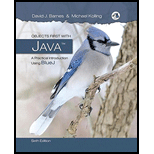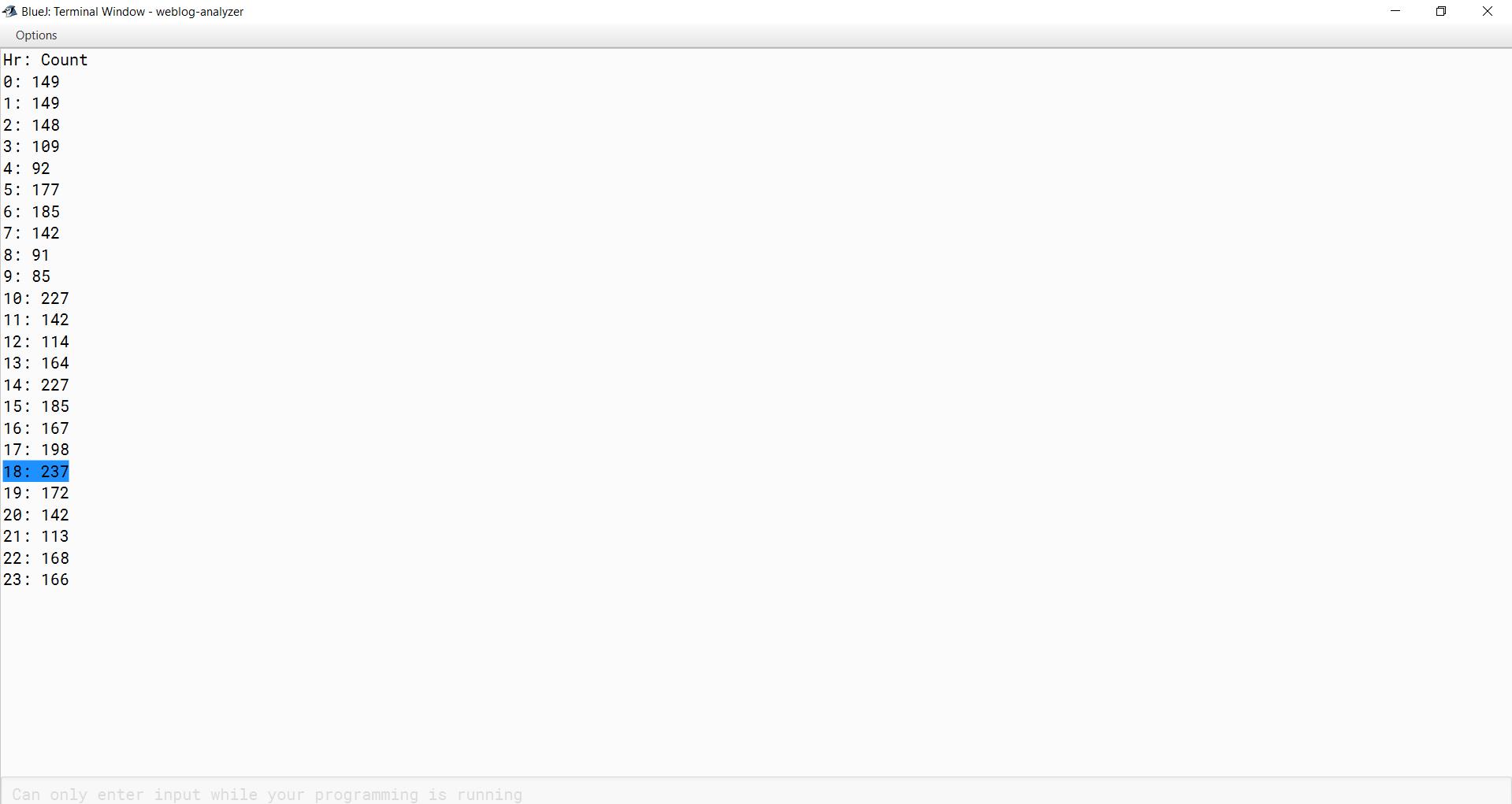
Explanation of Solution
Given: The weblog-analyzer project with LogAnalyzer class, analyzeHourlyDataas well as printHourlyCounts methods.
To find:Â The busiest times of the day.
Solution:
The busiest times of the day is 18 as it has the maximum count which is 237.
Right click on the LogAnalyzer class and click on new LogAnalyzer() to create an object.

After that, a new box will pop out in which the user can rename the reference name of the object, then click on the ok button.

A new rectangular box will occur at the bottom of the BlueJ window.

After that, right click on the rectangular box, and then click on analyzeHourlyData() to invoke analyzeHourlyData method.

After that, click on the printHourlyCounts() to invoke the printHourlyCounts method.

After invoking the method, a new window will pop out where the user can analyse the busiest time of the day.

Hence, the busiest time of the day is 18.
Want to see more full solutions like this?
Chapter 7 Solutions
Objects First with Java: A Practical Introduction Using BlueJ (6th Edition)
- Complete the following code. Attach the simulation too.arrow_forwardUse the debugger to examine the clock-display project. Set breakpoints in the ClockDisplay constructor and each of the methods, and then singlestep through them. How do you feel about the way it's behaving? Have you gained any fresh insights as a result of this? If this is the case, what exactly were they?arrow_forwardImplement the following by extending the Cubes project. For all shapes, there should be no colocated vertices. For the meshes, you may use arbitrary indexed convex-polygon faces that G3D will automatically tessellate into triangles on load. This project's report requires you to plan your approach before you begin writing code, so read the whole document before beginning implementation. Create data-files/model/cube.off, an axis-aligned cube with unit edge lengths, centered at the origin. You may make this file in a text editor directly, or write a procedure to generate it. Create a procedure (function or method) named makeCylinderthat generates a file data-files/model/cylinder.off given a radius and height. This file should be an indexed convex-polygon mesh for a cylinder about the yy-axis that is centered at the origin. Create a user interface for invoking makeCylinder. Use number boxes for the parameters and a button labelled “Generate” to actually launch the execution. Display a…arrow_forward
- Implement front end for online dental clinic system with explaination of the code, then make these requirments: -Brief about the used technology. -Screenshots of all pages with descriptions.arrow_forwardIt is time for you to demonstrate your skills in a project of your own choice. You must DESIGN,ANALYSE AND CODE any method for the GENERIC MyLinkedList class that will manipulate the linkedlist. You can decide yourself what it should be following the specification below:1. Purpose: The method must make logical sense – it should be of some purpose to somebody.You should describe in the text who will use the method for which purpose.2. Clearly explain the problem. Then clearly explain how your method will solve it.3. Test program: Test the method using a wrapped class like Integer however, you will get extramarks if you can test it with the new classes you created in I_Do1 and I_Do2.arrow_forwardIt is time for you to demonstrate your skills in a project of your own choice. You must DESIGN,ANALYSE AND CODE any method for the GENERIC MyLinkedList class that will manipulate the linkedlist. You can decide yourself what it should be following the specification below:1. Purpose: The method must make logical sense – it should be of some purpose to somebody.You should describe in the text who will use the method for which purpose.2. Clearly explain the problem. Then clearly explain how your method will solve it.3. Test program: Test the method using a wrapped class like Integer wrapper class. All of this must be done using generic linked lists, and coded in java.arrow_forward
- It is time for you to demonstrate your skills in a project of your own choice. You must DESIGN,ANALYSE AND CODE any method for the GENERIC MyLinkedList class that will manipulate the linkedlist. You can decide yourself what it should be following the specification below:1. Purpose: The method must make logical sense – it should be of some purpose to somebody.You should describe in the text who will use the method for which purpose.2. Clearly explain the problem. Then clearly explain how your method will solve itarrow_forwardthe answer dose not include the main method. Write a main method inside the LibraryManagementSystem class, create a menu system that allows the Librarian input commands to interact with the system. Below is the menu system that students should aim to recreate. Give an appropriate message after each action to notify the Librarian if an action was successful. Make use of the toString() to print the Book objects.arrow_forwardIn this project, you are going to introduce a Netflix-like (or Amazon prime video/Hulu/Apple+/Disney+) menu, composed by categories, each of which consists of a list of movies. Namely, there are a number of rows. For each row, users can browse movies in a circular way. For all rows/categories, users could browse up and down but not in a circular way. With the above background, please implement a Netflix-like menu using (1) DLL for connecting the beginning of all rows/categories; (2) each row/category is constructed by a CLL. A possible illustration of the above concepts is shown at the end of the file. Note that there is more than one way to implement the relationship between DLL and CLLS here (and the header of a CLL is not shown here because of a variety of possible implementations. You are required to introduce a header for each CLL). For the entire Netflix, here are the features included: a. Add a new category by name (e.g., void addCategory(string name)) b. Search a category by…arrow_forward
- Create a Word doc (.docx) with Java . As a user, I want to create a Word document so that I can print a paper copy of a quiz. Generate a Word document that reflects a Canvas quiz. The creation of this Word document follows the method (if appropriate) that the Canvas quiz is generated. For example, pulling random questions from a test bank, assigning specific points to each question, randomizing multiple choice answer order, etc.arrow_forwardWhat is a HashMap? What is its purpose and how do you use it? Answer these questions in writing, and use the Java library documentation of Map and HashMap for your responses. Note that you will find it hard to understand everything, as the documentation for these classes is not very good. We will discuss the details later in this chapter, but see what you can find out on your own before reading on.arrow_forwardUsing the Get-Help cmdlet will show us the help file of a cmdlet or topic. In this case, the Get-EventLog cmdlet. However, it is not showing the information on the parameters. How can we make it show the information on parametersarrow_forward
 Database System ConceptsComputer ScienceISBN:9780078022159Author:Abraham Silberschatz Professor, Henry F. Korth, S. SudarshanPublisher:McGraw-Hill Education
Database System ConceptsComputer ScienceISBN:9780078022159Author:Abraham Silberschatz Professor, Henry F. Korth, S. SudarshanPublisher:McGraw-Hill Education Starting Out with Python (4th Edition)Computer ScienceISBN:9780134444321Author:Tony GaddisPublisher:PEARSON
Starting Out with Python (4th Edition)Computer ScienceISBN:9780134444321Author:Tony GaddisPublisher:PEARSON Digital Fundamentals (11th Edition)Computer ScienceISBN:9780132737968Author:Thomas L. FloydPublisher:PEARSON
Digital Fundamentals (11th Edition)Computer ScienceISBN:9780132737968Author:Thomas L. FloydPublisher:PEARSON C How to Program (8th Edition)Computer ScienceISBN:9780133976892Author:Paul J. Deitel, Harvey DeitelPublisher:PEARSON
C How to Program (8th Edition)Computer ScienceISBN:9780133976892Author:Paul J. Deitel, Harvey DeitelPublisher:PEARSON Database Systems: Design, Implementation, & Manag...Computer ScienceISBN:9781337627900Author:Carlos Coronel, Steven MorrisPublisher:Cengage Learning
Database Systems: Design, Implementation, & Manag...Computer ScienceISBN:9781337627900Author:Carlos Coronel, Steven MorrisPublisher:Cengage Learning Programmable Logic ControllersComputer ScienceISBN:9780073373843Author:Frank D. PetruzellaPublisher:McGraw-Hill Education
Programmable Logic ControllersComputer ScienceISBN:9780073373843Author:Frank D. PetruzellaPublisher:McGraw-Hill Education





